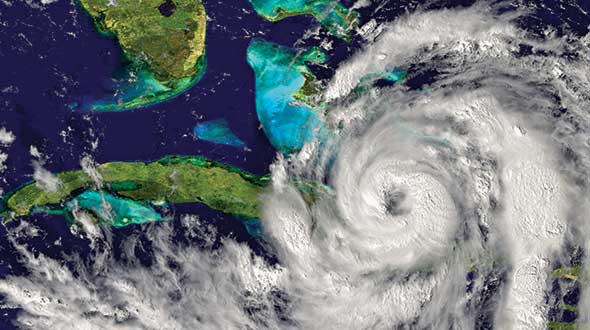Propane’s role in hurricane relief efforts
Propane’s prominent place as a highly effective fuel for disaster relief was enhanced by the industry’s role in alleviating some of the misery associated with Hurricanes Harvey and Irma.
“There are plenty of stories about how propane is getting the job done,” reports Mollie O’Dell, communications director at the National Propane Gas Association (NPGA).
In addition to having propane-powered vehicles ready to roll during an acute gasoline shortage, those in the hurricane zones are benefiting from propane generators, pumps, pressure washers, cooking equipment and mosquito control devices. Cellphone towers have the electricity needed to still send and receive signals – due to propane. First responders and households appreciate taking hot showers, and propane allows them to wash and dry their soggy clothes. Propane-powered air conditioning assists are beating oppressive heat and humidity.
According to Tucker Perkins, president and CEO of the Propane Education & Research Council (PERC), “Propane is the fuel of choice in emergency situations, and the industry responded with vigor. When it’s all said and done, the response was incredible. We saw that propane got into those communities quickly.”
Robust distribution network
During Harvey’s onslaught, a year’s worth of rain fell on Mont Belvieu over a four-day period, amounting to 51.88 inches – the highest single-event total ever recorded in the contiguous United States.
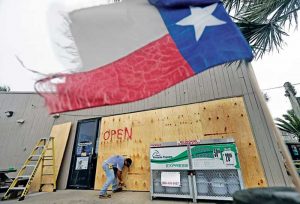
Ramon Lopez boards up windows of a business in Galveston, Texas, ahead of Hurricane Harvey. At left, a satellite image shows a massive hurricane as it bears down on Florida. Photo: REX/Shutterstock.com
Just as big snow is a fact of life in northern climates, so it is with big rain, hurricanes and storm surges along the Gulf Coast, and petroleum facilities are constructed accordingly. Thus, propane’s infrastructural apparatus experienced mostly temporary disruptions due to pooling floodwaters and power outages.
Train traffic was slowed as washed-out track beds required repairs, and transports and drivers were diverted to deliver gasoline. As Irma approached Florida, some 7 million people evacuated, making it the largest mass evacuation in American history. As gasoline was difficult-to-impossible to obtain, PERC was promoting propane autogas as an alternative fuel for first responders, according to Perkins.
Mont Belvieu brine ponds used for pushing propane in and out of storage caverns were diluted by rainwater, causing supply delays. According to Debnil Chowdhury, director of natural gas liquids (NGLs) at IHS Markit, the facility even had trouble getting operators into work, as employees were waylaid by the flooding.
“Issues will crop up as NGL production assets are brought back to full capacity,” he says, noting that more will be known by October regarding any lingering impacts.
Asian propane purchasers went on a buying spree sparked by concerns over the looming possibility of long-term supply shortages.
“This is the first hurricane that hit Mont Belvieu after the U.S. became a major exporter,” Chowdhury says. “All of the export terminals shut down, and the price spiked in Japan.”
Since June, pricing has been on an upswing and a brisk post-hurricane increase in overseas sales was yielding a reduced pre-winter build in the United States. In mid-September, the Energy Information Administration reported that the nation’s domestic propane stocks were 20.6 percent lower than last year’s levels.
“Harvey caused about a week of disruptions out of the Mont Belvieu complex,” Perkins says. “We had product from a lot of other sources, and our industry was able to stay active. It shows how far we’ve come in having a robust distribution network throughout the country. Propane’s price did not go up the way gasoline and diesel prices did.”
Boots on the ground
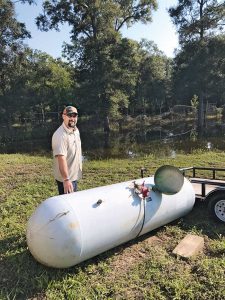
A propane tank in Texas was flipped on its side due to massive flooding caused by Hurricane Harvey, which dropped 40-60 inches of rain over a four-day period. Photo by Bill Van Hoy
A large array of relevant tip sheets available through NPGA and PERC provided crucial readiness and response advice prior to Harvey and Irma’s arrival and throughout the aftermath, according to Jackie Mason of the Texas Propane Gas Association (TPGA) and the Propane Council of Texas (ProCoT).
“We were sending out daily communications to our membership to keep all our marketers in the loop,” she says.
Mason has particular praise for Bill Van Hoy, who serves as the executive director of TPGA and ProCoT. According to Mason, Van Hoy contacted every retailer in the affected regions.
Van Hoy noted that marketers needed specific resources. These included disseminating messaging for customers via the PERC and NPGA materials, as well as providing physical assistance for retailers overwhelmed by the amount of people they had to service.
“A lot of other state associations called and asked how they can help, and we coordinated the volunteer effort,” Van Hoy recounts.
Retailers will not know the number of customers they lost until sorting through all of their work orders in an effort to restore service to customers, according to Van Hoy.
The association has also established the TXPGA Disaster Relief Fund to help offset the cost of destroyed propane equipment at customers’ homes.
Some propane providers had flooding, wind damage and other setbacks, but they remained operational.
“All you need is a driver, a truck and some gas and you’re in business; it’s a can-do attitude,” Van Hoy explains. “It slowed them down, but it’s not going to put them out of business.”
Dale Calhoun, executive director of the Florida Propane Gas Association (FPGA), was actively involved with the Florida governor’s emergency response team, and after the storm he contacted affected retailers, Perkins says.
“Supply has been our problem, except for what people had in their bulk plants,” Calhoun says. “It’s getting a little better, but it’s nothing to write home about. We’ve been taking care of critical facilities. People had to ration propane, and the dealers themselves had to ration their propane.”
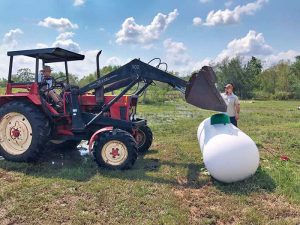
Retailers in Texas work to reset a propane tank that was moved by the floodwaters of Hurricane Harvey. Photo by Bill Van Hoy
The FPGA has been focusing on restoring service to first responder bases, hospitals, nursing homes, traffic control equipment and cellphone towers.
“We’ve had to get creative to get customers gas,” says consultant Allan Degenhardt at Propane Resources. “One of our clients had to drive 400 miles at times to get propane.”
At one point, 6.7 million Florida electricity meters had stopped spinning, and as of mid-September 391,000 account holders and their families still remained in the dark amid sweltering heat and humidity. In Florida, air conditioning is widely viewed as a public health necessity. Having propane to keep air conditioners cooling eased a lot of discomfort.
There are many industry crews involved in Florida’s recovery efforts.
“They say it’s brutal and rugged down there,” Degenhardt reports. “They’re working at night, too, because they’re very busy, the traffic is so busy during the day, and people are panicked,” he continues. “And they’re coming in contact with snakes, ’gators and the whole bit.”
Due to vast expanses of flooding, the lifting and moving of tanks is the biggest problem associations have faced, according to Randy Hayden, executive director of the Louisiana Propane Gas Association. Marketers throughout the hurricane zones were busy retrieving tanks that had floated away.
“Everyone we’ve talked to felt that they were in pretty good shape,” Hayden says. “Their priority was to help first responders and customers. Our main purpose was to provide ready sources of propane for first responders. We were able to help people get those supplies without any interruptions.”
According to Hayden, preparation is key in emergency situations. Companies were prepared and therefore they have been able to help customers and industry members, despite the overwhelming circumstances.
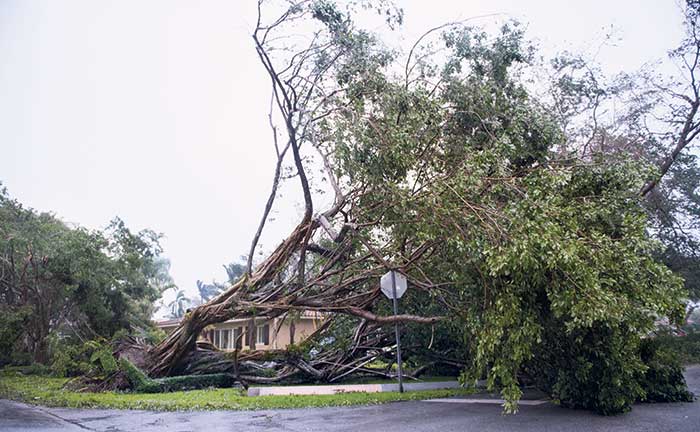
Hurricane Irma made landfall in Florida on Sept. 10 as a Category 4 storm. Many industry crews have been involved in Florida’s recovery and clean-up efforts. Photo: iStock.com/liography
Doing double-duty
Propane-powered generators, pumps, water heaters, pressure washers and other appliances – especially cooking units for families forced into involuntarily camping out – have been crucial for all manner of safety and comfort applications in the hurricane zones.
Generac pre-positioned merchandise at distributors a week before Harvey and Irma swept ashore.
“We are now sending additional units to be sure that everyone who needs a portable generator has access to one,” says president and CEO Aaron Jagdfeld.
The company has also sent out disaster response teams to assist with service, parts and supplies.
The industry has done exceptionally well in executing priority delivery of refills for stationary tanks and maintaining inventories of 20-pound cylinders.
“Propane is extremely valuable and in high demand during named storms, and we’re proud of the role Blue Rhino and Ferrellgas can provide during these challenging times,” says Chris J. Hartley, vice president of marketing. “Our team is practiced and well positioned to handle those types of challenges. Blue Rhino certainly plays an important role in good times in backyards, but when bad times come people need our products even more.”
The company sponsors the non-profit organization Operation BBQ Relief project, which mobilized into Texas and quickly served up more than 300,000 meals to first responders and residents driven from their homes.
More on Hurricane Harvey relief efforts:








